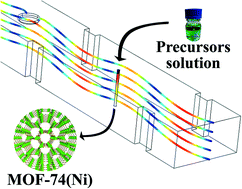Gas–liquid segmented flow microwave-assisted synthesis of MOF-74(Ni) under moderate pressures
Abstract
The metal organic framework, MOF-74(Ni), was synthesized in a continuous flow microwave-assisted reactor obtaining a high space-time yield (~90 g h−1 L−1) and 96.5% conversion of reagents. Separation of the nucleation and growth steps was performed by using uniform and rapid microwave heating to induce nucleation, which allowed a substantial increase in conversion for shorter reaction times under mild pressure. High yields were achieved in minutes, as opposed to days for typical batch syntheses, with excellent control over the material's properties due to more uniform nucleation, and the separation of the nucleation and growth steps. Optimization of the microwave reactor parameters led to improvements in MOF-74(Ni) crystallinity, reagent conversion, and production rates. Differences in MOF-74(Ni) crystallinity were observed as smaller grains were formed when higher microwave zone temperatures were used. Crystallinity differences led to different final adsorption properties and surface areas. Herein we show that a continuous high space-time yield synthesis of MOF-74(Ni) allows control over nucleation using microwave heating.


 Please wait while we load your content...
Please wait while we load your content...